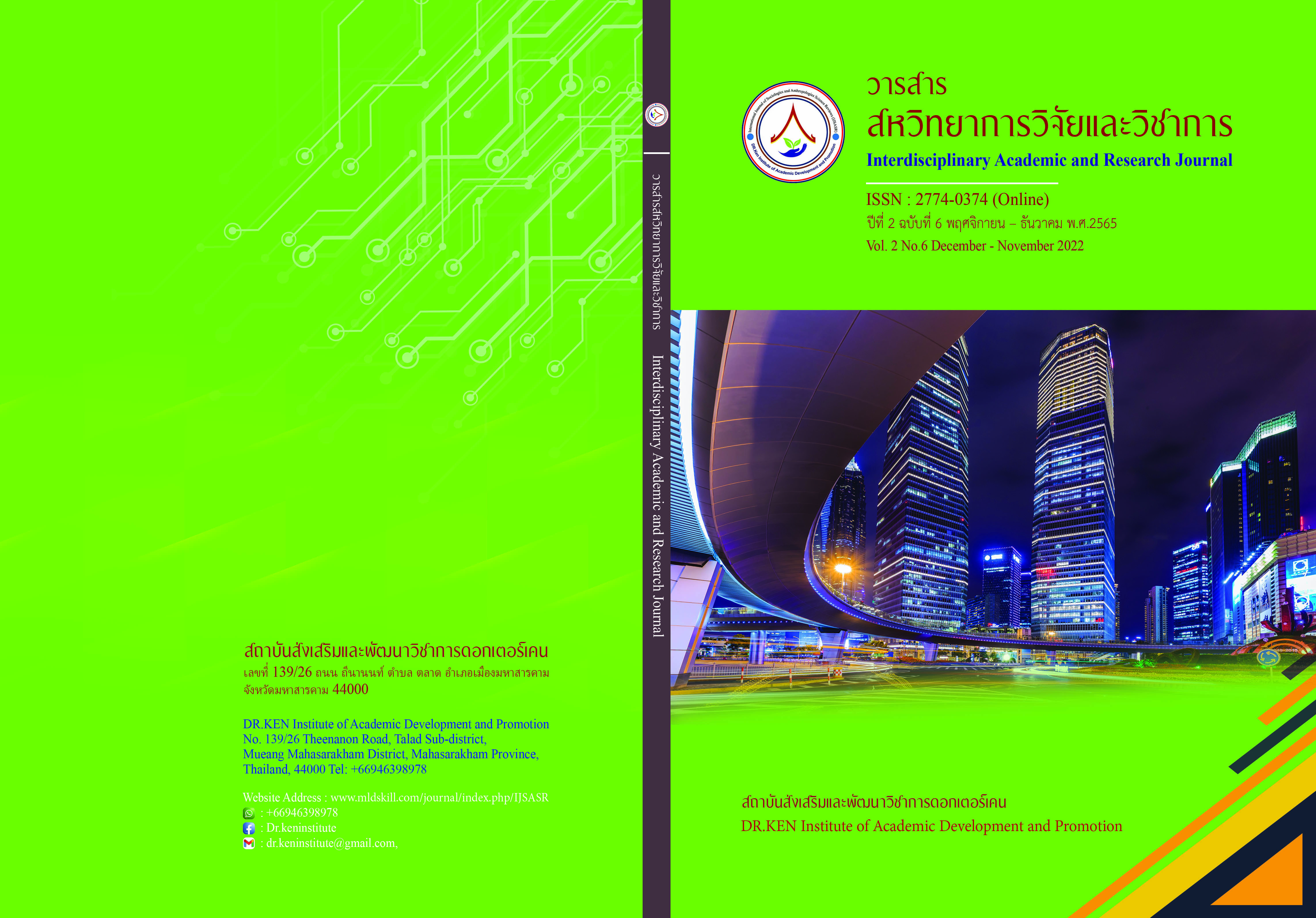Management Factors that Affect the Competitiveness of Entrepreneurs in the Thai Garment Industry
DOI:
https://doi.org/10.14456/iarj.2022.157Keywords:
Management;, Competitiveness; , Entrepreneurship; , Garment IndustryAbstract
The textile and garment industry in Thailand has to face rising production costs. As a result, manufacturers began to move their production bases to neighboring countries in the ASEAN region until affecting these countries became a major competitor in Thailand The neighboring countries that have clearly started to play a more important role are Vietnam and Indonesia. The researcher is therefore interested in the study of Management factors affecting the competitiveness of entrepreneurs in the Thai garment industry. The objectives of this study were 1) to study the competitiveness of entrepreneurs in the Thai garment industry 2) to compare the competitiveness of entrepreneurs in the Thai garment industry classified by business attributes 3) to study the factors management that affects the competitiveness of entrepreneurs in the Thai garment industry. This study was a quantitative study. The sample group used in the study was representatives of entrepreneurs in the garment business of 327 people using a questionnaire with the index of consistency (IOC) equal to 0.93 and the alpha coefficient for each item between 0.79-0.98 and the overall questionnaire was equal 0.87. Statistics used for data analysis were mean, standard deviation, t-test, one-way analysis of variance (ANOVA), and multiple regression analysis (MRA). The study found that 1) The competitiveness of entrepreneurs in the Thai garment industry as a whole was at a high level, less as follows The cost advantage, followed by differentiation, and market focus, respectively. 2) Entrepreneurs with registered capital net income per year and the duration of business operation is different, there is a difference in competitiveness. 3) Management factors together explained the overall competitiveness of Thai garment industry entrepreneurs at 58.10 percent with a statistical significance at the .01 level. Planning, Production, Innovation, Marketing have a positive influence on the competitiveness of entrepreneurs in the overall Thai garment industry statistically significant at the 0.01 level.
References
กรมพัฒนาธุรกิจการค้า. (2557). การจัดทำบัญชีและงบการเงิน. นนทบุรี : กรมพัฒนาธุรกิจการค้า. กระทรวงพาณิชย์.
กรมส่งเสริมการค้าระหว่างประเทศ. (2564). ในช่วง 5 เดือนแรกของปี 2564 การส่งออกสิ่งทอและเครื่องนุ่งห่มของเวียดนามมีมูลค่า 15,200 ล้านเหรียญสหรัฐฯ. กรุงเทพฯ: กระทรงพาณิชย์.
ก้องเกียรติ บูรณศรี. (2554). แบบจำลองความสัมพันธ์เชิงสาเหตุระหว่างความเป็นผู้ประกอบการขององค์การสภาพแวดล้อมทางธุรกิจ และผลการดำเนินงานของสถานประกอบการอุตสาหกรรมการผลิต. U Academic Review, 9 (2), 146-158.
ชูชีพ เอื้อการณ์. (2557). แนวทางการส่งเสริมและพัฒนาอุตสาหกรรมสิ่งทอไทยเพื่อการแข่งขันระดับโลก. วิทยานิพนธ์รัฐประศาสนศาสตรดุษฎีบัณฑิต มหาวิทยาลัยราชภัฏวไลยอลงกรณ์ ในพระบรมราชูปถัมภ์.
ฐานวัฒน์ ฉัตรวิริยานนท์ .(2563).การพัฒนาขีดความสามารถการแข่งขันของผู้ประกอบการเครื่องนุ่งห่มไทยอย่างยั่งยืน.ปรัชญาดุษฎีบัณฑิต สาขาการบริหารการพัฒนา มหาวิทยาลัยราชภัฏสวนสุนันทา.
ฐิตา เภกานนท์. (2562). ปลดล็อก SMEs ไทย ปรับตัวอย่างไรให้เติบโต บทสรุปจากแบบสำรวจกว่า 2,400 ราย. กรุงเทพฯ: ฝ่ายนโยบายโครงสร้างทางเศรษฐกิจ ธนาคารแห่งประเทศไทย.
ณัฐกานต์ พวงไพบูลย์. (2562). เทคโนโลยีการผลิตสำหรับอุตสาหกรรมสิ่งทอและเครื่องนุ่งห่มไทย. คณะเทคโนโลยีอุตสาหกรรม มหาวิทยาลัยราชภัฏเทพสตรี.
ไตรถิกา พิชิตเดช และคณะ. (2557). รายงานการวิจัยการสังเคราะห์งานวิจัยด้านอุตสาหกรรมเครื่องนุ่งห่ม. กรุงเทพฯ: มหาวิทยาลัยเทคโนโลยีราชมงคลพระนคร.
ธนพล สุขเวสโก .(2561).แนวทางการจัดการอุตสาหกรรมเสื้อผ้าสำเร็จรูปสู่ความยั่งยืน. บริหารธุรกิจดุษฎีบัณฑิต คณะบริหารธุรกิจ มหาวิทยาลัยเทคโนโลยีพระจอมเกล้าพระนครเหนือ.
มานพ ชุ่มอุ่น. (2554). การพัฒนากระบวนการจัดการทางการตลาดในผลิตภัณฑ์จากผ้าฝ้ายทอมือ กรณีศึกษา: กลุ่มผ้าฝ้ายทอมือบ้านดอนหลวง ตำบลแม่แรง อำเภอป่าซาง จังหวัดลำพูน. เชียงใหม่: มหาวิทยาลัยราชภัฎเชียงใหม่.
มีเดียน จูมะ. (2562). ทฤษฎีความอยู่รอดในมิติของผู้ประกอบการ. [Online] https://pattanieconomy.wordpress.com/2019/06/02. [10 สิงหาคม 2564]
ศูนย์ข้อมูลและดิจิทัลอุตสาหกรรม สถาบันพัฒนาอุตสาหกรรมสิ่งทอ. (2564). อุตสาหกรรมสิ่งทอกับBCG ECONOMY.โครงการศูนย์สารสนเทศอัจฉริยะอุตสาหกรรมแฟชั่น ปี 2564. กรุงเทพฯ:สถาบันพัฒนาอุตสาหกรรมสิ่งทอ.
ศูนย์วิจัยกสิกรไทย. (2563). ธุรกิจ SMEโลจิสติกส์ปรับกลยุทธ์รับโอกาสและความท้าทายในยุค 4.0. [Online]: https://www.kasikornresearch.com/TH/K-EconAnalysis/Pages/search.aspx. [20 กรกฎาคม 2563]
สถาบันพัฒนาสิ่งทอ และสำนักงานเศรษฐกิจอุตสาหกรรม. (2562). ภาวะเศรษฐกิจอุตสาหกรรม ธันวาคม 2562. กรุงเทพ:สถาบันพัฒนาสิ่งทอ และสำนักงานเศรษฐกิจอุตสาหกรรม.
สุดใจ ผ่องแผ้ว และนุจรี ภาคาสัตย์ .(2559). รูปแบบความสามารถทางการแข่งขันของผู้ประกอบการ OTOP ที่เป็น SMEs ในประเทศไทย. Veridian E-Journal Silpakorn University, 9 (3), 1659-1675.
อนุพงษ์ อินฟ้าแสง. (2560). วิจัยศักยภาพการปรับตัวเข้าสู่ตลาดโลกของอุตสาหกรรมสิ่งทอและเครื่องนุ่มห่มไทย. วารสารวิชาการมหาวิทยาลัยธนบุรี. 11(26), 104-115.
Berisha & Pula. (2015). Defining Small and Medium Enterprises: a critical review. Academic Journal of Business, Administration, Law and Social Sciences, 1 (1), 17-28. https://iipccl.org/wp-content/uploads/2015/03/Ajbals-17-28.pdf
Chen, H. (2003). Relationships of Teamwork Skills with Performance Appraisals and Salary Information in a Taiwanese. High-performance Work Organization (China).
Fahy, J. (2000), "The resource‐based view of the firm: some stumbling‐blocks on the road to understanding sustainable competitive advantage", Journal of European Industrial Training, Vol. 24 No. 2/3/4, pp. 94-104. https://doi.org/10.1108/03090590010321061
Kotler, P. (2012). Marketing Management. Pearson Education. New Jersey: Prentice Hall.
Downloads
Published
How to Cite
Issue
Section
License
Copyright (c) 2022 พลกฤต โสลาพากุล, สานิต ศิริวิศิษฐ์กุล , ณัฐภัสสร ธนาบวรพาณิชย์

This work is licensed under a Creative Commons Attribution-NonCommercial-NoDerivatives 4.0 International License.
Copyright on any article in the Interdisciplinary Academic and Research Journal is retained by the author(s) under the under the Creative Commons Attribution-NonCommercial-NoDerivatives 4.0 International License. Permission to use text, content, images, etc. of publication. Any user to read, download, copy, distribute, print, search, or link to the full texts of articles, crawl them for indexing, pass them as data to software, or use them for any other lawful purpose. But do not use it for commercial use or with the intent to benefit any business.
















.png)


